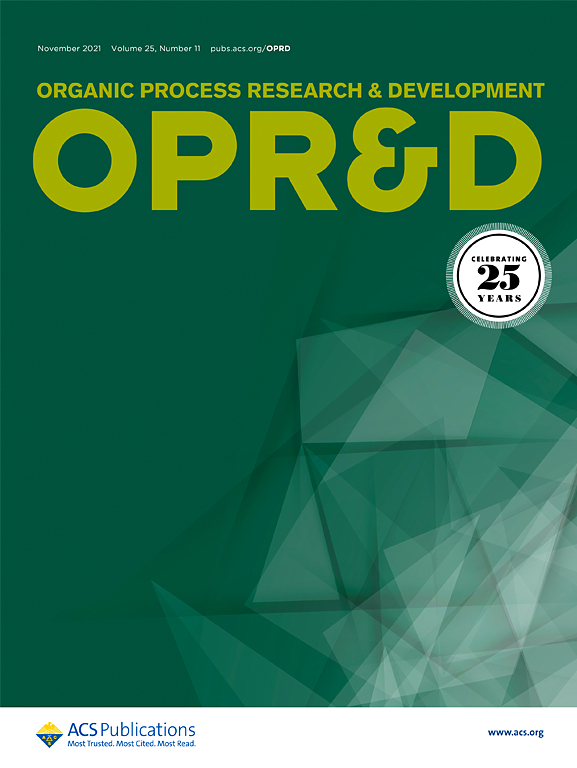Therapeutic Peptides Control Strategy: Perspective on Current Industry Practices
IF 3.5
3区 化学
Q2 CHEMISTRY, APPLIED
引用次数: 0
Abstract
There is currently a lack of harmonization from health agencies on the control strategies that should be implemented for the manufacture of synthetic peptide active pharmaceutical ingredients throughout clinical development and commercialization. In this Perspective, we use the term “peptide” to refer to an α-amino acid polymer with a specific defined sequence without regard to the total number of amino acids that it contains. In the U.S., the FDA currently defines “proteins” that are subject to biological product licensure as follows: “A protein is any alpha amino acid polymer with a specific, defined sequence that is greater than 40 amino acids in size. When two or more amino acid chains in an amino acid polymer are associated with each other in a manner that occurs in nature, the size of the amino acid polymer for purposes of this paragraph (h)(6) will be based on the total number of amino acids in those chains, and will not be limited to the number of amino acids in a contiguous sequence” [21 CFR 600.3(h)(6)]. In contrast, other regulatory authorities apply requirements based on the method of manufacture, resulting in regulatory risks of disparate requirements depending on the jurisdiction. To provide visibility into current industry practices on the control strategies applied to synthetic peptides, a benchmark survey of member companies of the IQ Consortium was conducted. This work provides a comprehensive analysis of the survey results. The compiled responses from 10 companies reveal that while most follow similar control strategies for identification, purity, and assay testing, none of the survey questions received a unanimous response. Interestingly, the number and type of analytical techniques utilized for each test differed when comparing the phase of development, the number of amino acids in the peptide, and whether it was for the drug substance or drug product. Additionally, the limits set for impurity reporting, identification, and qualification thresholds throughout development varied widely. The knowledge acquired from the survey in combination with previously published literature and individual company experiences enables the IQ Consortium to put forth appropriate recommendations to achieve harmonization of control strategies for synthetic peptides with regard to assay, identity, impurity reporting and identification thresholds, bioassay, and comparability assessments.

治疗性多肽控制策略:当前工业实践的观点
目前,卫生机构在整个临床开发和商业化过程中对合成肽活性药物成分的生产应实施的控制战略缺乏统一。在本观点中,我们使用术语“肽”来指代具有特定定义序列的α-氨基酸聚合物,而不考虑其包含的氨基酸总数。在美国,FDA目前对受生物制品许可约束的“蛋白质”的定义如下:“蛋白质是任何具有大于40个氨基酸大小的特定定义序列的α氨基酸聚合物。当氨基酸聚合物中的两个或多个氨基酸链以自然界中发生的方式相互结合时,本段(h)(6)中氨基酸聚合物的大小将基于这些链中氨基酸的总数,而不限于连续序列中的氨基酸数量”[21 CFR 600.3(h)(6)]。相比之下,其他监管机构根据制造方法应用要求,导致因管辖范围不同而产生不同要求的监管风险。为了提供当前工业实践中应用于合成肽的控制策略的可视性,对IQ联盟的成员公司进行了基准调查。这项工作对调查结果进行了全面的分析。来自10家公司的汇编回复显示,虽然大多数公司在鉴定、纯度和分析测试方面遵循类似的控制策略,但没有一个调查问题得到一致的回应。有趣的是,在比较开发阶段、肽中氨基酸的数量以及是用于原料药还是药品时,每次测试所使用的分析技术的数量和类型都有所不同。此外,在整个开发过程中,杂质报告、鉴定和鉴定阈值的限制范围变化很大。从调查中获得的知识与先前发表的文献和个别公司的经验相结合,使IQ联盟能够提出适当的建议,以实现合成肽在测定、鉴定、杂质报告和鉴定阈值、生物测定和可比性评估方面的控制策略的协调。
本文章由计算机程序翻译,如有差异,请以英文原文为准。
求助全文
约1分钟内获得全文
求助全文
来源期刊
CiteScore
6.90
自引率
14.70%
发文量
251
审稿时长
2 months
期刊介绍:
The journal Organic Process Research & Development serves as a communication tool between industrial chemists and chemists working in universities and research institutes. As such, it reports original work from the broad field of industrial process chemistry but also presents academic results that are relevant, or potentially relevant, to industrial applications. Process chemistry is the science that enables the safe, environmentally benign and ultimately economical manufacturing of organic compounds that are required in larger amounts to help address the needs of society. Consequently, the Journal encompasses every aspect of organic chemistry, including all aspects of catalysis, synthetic methodology development and synthetic strategy exploration, but also includes aspects from analytical and solid-state chemistry and chemical engineering, such as work-up tools,process safety, or flow-chemistry. The goal of development and optimization of chemical reactions and processes is their transfer to a larger scale; original work describing such studies and the actual implementation on scale is highly relevant to the journal. However, studies on new developments from either industry, research institutes or academia that have not yet been demonstrated on scale, but where an industrial utility can be expected and where the study has addressed important prerequisites for a scale-up and has given confidence into the reliability and practicality of the chemistry, also serve the mission of OPR&D as a communication tool between the different contributors to the field.

 求助内容:
求助内容: 应助结果提醒方式:
应助结果提醒方式:


